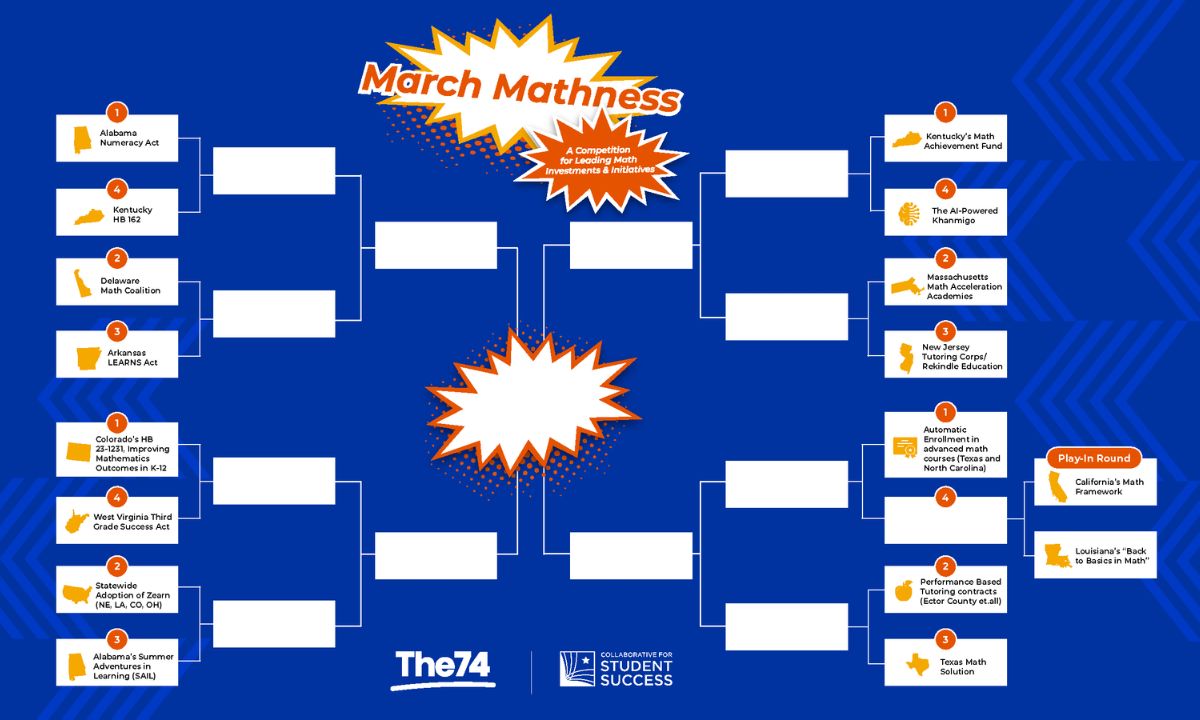Introducing the March Mathness Tournament
Cowen: See how some of the most promising state and local math practices stack up against one another in this March Madness-style bracket.

Get stories like this delivered straight to your inbox. Sign up for The 74 Newsletter
Not a math person, you say? If you’re one of the millions who embrace the wild and intense excitement of the NCAA basketball tournament each March, then I beg to differ.
Let’s start with the army of statisticians and experts who apply the complicated formula to land on a bracket of 68 college teams. Follow that up with the extreme anticipation felt by wanna-be analysts — like myself — eager to win the coveted office pool. We watch videos, research injuries and ponder scoring differentials. And then we watch the flurry of games, diligently recording the results and projecting our probability of victory: “If team X loses this game, the most points I could possibly achieve for this region is Y.”
In other words, March Madness involves an awful lot of math.
And yet, kids aren’t doing so well at math right now. In fact, math scores for the nation’s 9– and 13-year-olds are at multi-decade lows.
Much of this is due to the pandemic. According to the latest findings from researchers at Harvard and Stanford, only one state, Alabama, has returned to its pre-pandemic achievement levels in math. They found that students made rapid progress last year, but the average student in third through eighth grade is still about one-third of a grade level behind in math, compared with 2019 performance.
Which policies or practices are helping students make the biggest gains in math? Which deserve to stick around or be replicated? These are the questions policymakers should be asking this year, especially as the final round of federal relief funds expires.
To help further that conversation, the Collaborative for Student Success is announcing a tournament of our own — March Mathness. All month long, we’ll be pitting some of the most promising state and local math practices against one another. We’ve convened a plucky panel of three expert judges — Chad Aldeman, Dale Chu and Jocelyn Pickford — to help us narrow the list and decide which ones deserve to, in legendary coach Jim Valvano’s words, “survive and advance.”
These leading math practices represent a sampling of the ways state leaders, district officials, teachers, parents and families can come together to advance math education for their students.
In the opening round of this Sweet 16, top-seeded statewide legislative efforts like Alabama’s Numeracy Act and Colorado’s Improving Mathematics Outcomes bill will challenge math proposals in the statehouses of Kentucky and West Virginia. Increasingly popular digital learning platforms will face off against innovative models for district tutoring contracts and comprehensive summer learning programs.

The matches will be hosted on EduProgress.org, and the final results will be shared out here on The 74 Million. Readers can follow along all month or root for their favorites on social media. So stay tuned — the Big (Math) Dance is nearly here!
Here are our top contenders:
AI-powered Khanmigo — The Khan Academy team has created a new AI-powered tool in hopes of providing personalized tutoring for students at a relatively low cost, while enabling teachers to quickly create customized lesson plans or rubrics. Early reviews suggest the tool, called Khanmigo, could be a helpful instructional aid, but others have noted that it has a tendency to make basic mathematical errors.
Alabama Numeracy Act — Comprehensive statewide legislation that ensures every elementary school has a math coach; and sets up a process to vet and approve high-quality instructional materials and curricula; creates a task force to help ensure teacher preparation programs are effective for new elementary math educators; establishes academies to help build a pipeline of principals trained in effective math intervention strategies.
Alabama’s Summer Adventures in Learning (SAIL) —Focuses on overcoming summer learning loss by bringing together youth and community groups, faith-based organizations, philanthropy, municipal agencies and schools to pool their knowledge and resources to create summer enrichment programs. In 2023, participating students gained an average of three months in math, marking the 11th straight summer the program has led to academic improvement.
Arkansas LEARNS Act — Signed into law last year, the measure requires that schools develop math intervention plans for third- through eighth-graders not performing at grade level. By the 2024-25 school year, each district must report the type of interventions they’re using and the number of students receiving them.
Automatic enrollment in advanced math courses (Texas and North Carolina) — The use of data to enroll low-income and students of color in advanced math classes — eliminating the need for parents and caregivers to opt their students into those classes — has helped to double the number of Black and brown students in accelerated math courses in Texas alone.
Colorado HB 23-1231, Improving Mathematics Outcomes in K-12 — Comprehensive statewide legislation that combines free training in evidence-informed practices for elementary school and secondary school mathematics educators, with a focus on the promotion and use of high-quality curricula and assessment.
Delaware Math Coalition — An alliance of leaders from public school districts, charter schools, colleges, the state Department of Education and the business sector have developed seven programs with the goal of delivering high-quality professional learning opportunities and experiences that advance effective math instruction.
Kentucky HB 162 — While not yet signed into law, this bill is noteworthy for targeting grades 4 to 8, rather than the early grades. The measure calls for increased access to “evidence-based high-quality instructional resources,” mandatory improvement plans for struggling students and universal math screening.
Kentucky’s Math Achievement Fund — Created back in 2005, this effort provides grants for math coaches, the purchase of high-quality materials and extra time for teachers to engage in professional learning of the new mathematics materials purchased. The Center for Analysis of Longitudinal Data in Education research finds that the program’s combination of targeted interventions, peer coaching and educator collaboration improved math achievement in grades K-3. Gains were also seen in other areas, like increased student attendance and decreased disciplinary incidents, and were evident across racial and ethnic groups.
Massachusetts Math Acceleration Academies — These are designed to offer added time on task in small-class settings, with four-plus hours of in-person math instruction for one week per student, during vacation weeks throughout the school year. The academies are required to use multiple forms of assessment to monitor student progress and enable teachers to tailor lessons to meet the needs of the students they are serving.
New Jersey Tutoring & Coaching Supports/Rekindle Education — The New Jersey Tutoring Corps serves students statewide in pre-K through eighth grade during school, after school and over the summer. Following seven to 15 weeks of high-impact tutoring, the program saw a 24 percentage point increase in the number of students performing at or above grade level — and 90% of students emerge from the program say they feel like they could help their friends with math. Complementing the statewide effort is a small pilot program offering math teachers one-on-one and small group coaching on core instructional strategies.
Performance-based tutoring contracts (Ector County, Texas, et al.) — An innovative approach that uses a “pay for success” model whereby tutoring companies earn more money if students make progress on the district’s interim assessments (MAP tests). This approach encourages providers to become more engaged and to follow up with students if they missed tutoring sessions, all while shifting the burden away from already overworked teachers.
Play-in Round: California’s Math Framework VS. Louisiana’s “Back to Basics in Math” — In perhaps the most talked-about policy change in math last year, the state of California approved a new learning framework for all public schools. The new framework, in the works for four years, is designed to connect learning to real-world uses of math and data, while helping to ensure that students see themselves in the curriculum and in math-related careers by making instruction more culturally relevant. Louisiana’s 2023 law requires math teachers in grades 4 to 8 to take additional professional development related to numeracy. School districts must report annually on the number who have successfully done so.
Statewide adoption of Zearn (Nebraska, Louisiana, Colorado, Ohio) — These states now offer this high-quality math supplemental resource free to all public school students. Studies show that consistent use of Zearn results in larger student gains on state assessments, including significant proficiency gains for the lowest-performing math students, English learners, Black and Latino students, and those eligible for free and reduced-price lunch.
Texas Math Solution — This interactive tool gives educators real-time data insights about student performance, and its middle school math program is rated all green on EdReports. Muleshoe Independent School District saw a 333% improvement on the state’s annual math assessment after switching to this curriculum. West Virginia’s Third Grade Success Act — Establishes an approved list of screeners and math benchmark assessments for K-3 students that must be given in the first 30 days of the school year, midyear and at the end of the year. This is a strong approach to thoughtful use of data to target supports and interventions based on student need and to develop individualized improvement plans for those not meeting benchmarks.
Get stories like these delivered straight to your inbox. Sign up for The 74 Newsletter

;)
